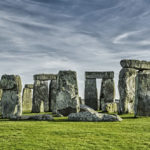 Music
Music  Music
Music  History
History 10 Less Than Jolly Events That Occurred on December 25
 Weird Stuff
Weird Stuff 10 Funny Ways That Researchers Overthink Christmas
 Politics
Politics 10 Political Scandals That Sent Crowds Into the Streets
 Weird Stuff
Weird Stuff Ten Bizarre Facts About The Doge Meme
 Our World
Our World 10 Ways Your Christmas Tree Is More Lit Than You Think
 Movies and TV
Movies and TV The 10 Coolest Stars to Set Sail on The Love Boat
 History
History 10 Things You Didn’t Know About the American National Anthem
 Technology
Technology Top 10 Everyday Tech Buzzwords That Hide a Darker Past
 Humans
Humans 10 Everyday Human Behaviors That Are Actually Survival Instincts
 Music
Music 10 Surprising Origin Stories of Your Favorite Holiday Songs
 History
History 10 Less Than Jolly Events That Occurred on December 25
 Weird Stuff
Weird Stuff 10 Funny Ways That Researchers Overthink Christmas
Who's Behind Listverse?

Jamie Frater
Head Editor
Jamie founded Listverse due to an insatiable desire to share fascinating, obscure, and bizarre facts. He has been a guest speaker on numerous national radio and television stations and is a five time published author.
More About Us Politics
Politics 10 Political Scandals That Sent Crowds Into the Streets
 Weird Stuff
Weird Stuff Ten Bizarre Facts About The Doge Meme
 Our World
Our World 10 Ways Your Christmas Tree Is More Lit Than You Think
 Movies and TV
Movies and TV The 10 Coolest Stars to Set Sail on The Love Boat
 History
History 10 Things You Didn’t Know About the American National Anthem
 Technology
Technology Top 10 Everyday Tech Buzzwords That Hide a Darker Past
 Humans
Humans 10 Everyday Human Behaviors That Are Actually Survival Instincts
10 Creepy Curses Hidden in Hieroglyphics
The history of Egyptian writing spans over 5,000 years, making it one of the oldest known writing systems in the world. It all began around 3,200 BC with the invention of hieroglyphs, a system of pictorial symbols used by the ancient Egyptians. Hieroglyphs were primarily used for religious and monumental inscriptions and adorned the walls of temples and tombs. The complexity of hieroglyphic writing made it accessible only to the elite, such as scribes and priests.
Over time, the Egyptian writing system evolved to include other scripts that were more accessible and practical. Around 2,600 BC, hieratic script emerged as a simplified and cursive form of hieroglyphs. It was used for everyday purposes like writing letters, keeping records, and writing on papyrus. The hieratic script was written with brush and ink, and its simplified forms allowed for faster writing. This was replaced in 700 BC by Egyptian demotic script, an even simpler and faster form of writing.
Hieroglyphics, until relatively recently, left scientists baffled. The decipherment of Egyptian hieroglyphs was achieved in the early 19th century by the French scholar Jean-François Champollion. So now that we are able to read what hieroglyphics say, we’re starting to uncover some pretty nefarious messages, including curses and warnings. Here are ten creepy curses hidden in hieroglyphics.
Related: 10 Amazing New Ancient Egyptian Discoveries, Including Mysterious Hieroglyphics
10 The Sheikh Abd el-Qurna Inscription
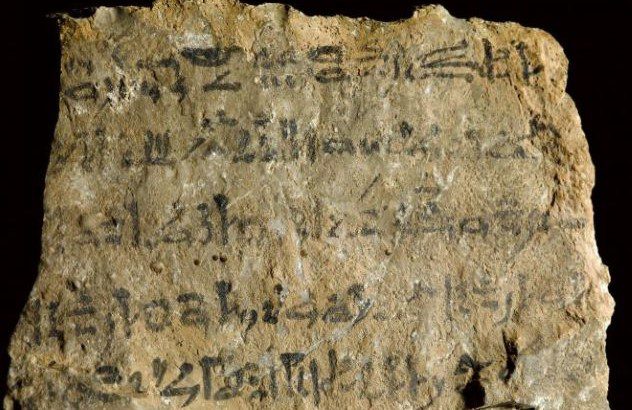
Sheikh Abd el-Qurna is a necropolis located in Thebes (modern-day Luxor) in Egypt. Since it’s a necropolis, there are a number of tombs located in this area, some of which contain eerie inscriptions meant to warn tomb raiders away.
One particular slab currently sits in the National Museum of Scotland and reads:
“Watch out not to take a pebble from within it outside. If you find this stone, you shall not transgress against it. Indeed, the gods since the time of Pre, those who rest in the mountains gain strength every day, even though their pebbles are dragged away.”
This eerie inscription written in hieratic basically warns people that if they remove even a stone from the tomb, they’ll have to face the wrath of the gods and the deceased. However, since the “message” stone itself was removed and taken to Scotland with little consequence, we’re probably safe disregarding this creepy message.[1]
9 Amenhotep Tomb Curse
Another tomb located in Egypt where you’ll find a spooky inscription is the tomb of Amenhotep. Amenhotep’s tomb is found in the Valley of the Kings, and there, a rather terrifying inscription warns trespassers not to disturb the sleeping king.
The inscription warns that anyone who attempts to steal from the tomb will lose their earthly wealth, drown at sea, be burned to death in a fiery furnace, have no successors, tomb, or funeral, and starve to death. They’re also warned that their bones will perish, likely alluding to an unpleasant afterlife.
This isn’t even the entire inscription, either! There are more punishments that are hurled at any trespassers who dare try to disturb the king. Luckily, at least in modern times, that curse doesn’t seem to have done much harm.[2]
8 The Mastabas at Saqqara
Although ancient Egyptians are famous for building the pyramids, they aren’t the only types of tombs that they constructed. They also built something called mastabas, which were flat-roofed tombs.
In Saqqara, more than 160 of these types of tombs were discovered. The tombs contain mummies, which are the embalmed bodies of deceased Egyptians.
While not all the tombs contain eerie inscriptions, some certainly do. According to archaeologists, some of the tombs at Saqqara contain colorful hieroglyphics, which give off warnings to anyone who’s considering looting them.
According to one professor at the American University of Cairo, these tombs condemn any “impure persons” who enter the tomb to be punished by the gods. The said punishment seems to have been that the gods would wring the person’s neck like a goose. Not exactly a pleasant way to meet your end.
One such inscription can be found on the mastaba of Khentika Ikhekhi. The inscription in his tomb reads, “As for all men who shall enter this my tomb impure, I shall seize his neck like a bird.”[3]
7 The Execration Texts
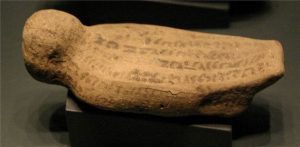
The execration texts are another eerie set of hieroglyphics, these ones dating back to the 24th to 22nd centuries BC. These texts aren’t one specific set of hieroglyphics but a number of different hieroglyphics that all follow the same pattern.
To explain, execration texts were pieces of pottery—often in the form of human-like figures—inscribed with curses. Unlike the curses placed in pharaohs’ tombs, these particular texts were typically directed against foreign neighbors or enemies of the state.
The way this particular curse worked was that ancient Egyptians would write the names of their enemies, along with a curse, on pieces of pottery or stone. Then, they would break those items and bury the pieces. In most cases, they were placed near ritual sites or on burial grounds.
The text on these shards read things such as “slaughter him with a knife” or “smite him with a spear,” cursing the foreigners and foreign cities named in the texts to a nasty death.[4]
6 The Tomb of Ankhtifi
Ankhtifi was an ancient Egyptian nomarch from around 2100 BC. And, while he may not have made it to pharaoh status, it seems that he still wasn’t taking any chances when it came to leaving his tomb unattended.
This nobleman left a creepy message crafted in hieroglyphics on the walls of his tomb. The inscription states that any ruler who may do evil to his coffin should be rejected by Hemen. He also condemns the potential tomb raider’s heirs to lose his inheritance.
While that may not have deterred archaeologists who excavated the tomb in modern times, it seems to have done the trick when it came to dissuading ancient Egyptian robbers from looting the grave.[5]
5 Sarenput I
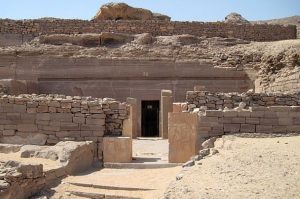
Ankhtifi wasn’t the only nomarch who left a nasty inscription on his tomb. Another such nomarch is a man named Sarenput I, who was a leader of Elephantine during the 12th dynasty. Sarenput I left an inscription in his tomb in order to protect the offerings left by one of the statues of the gods inside it.
The inscription states that anyone who tries to take the offerings from the statue within the tomb will meet a nasty fate: “His arm shall be cut off like that of this bull, his neck shall be twisted off like that of a bird, his office shall not exist, the position of his son shall not exist, his house shall not exist in Nubia, his tomb shall not exist in the necropolis, his god shall not accept his white bread, his flesh shall belong to the fire, his children shall belong to the fire, his corpse shall not be to the ground, I shall be against him as a crocodile on the water, as a serpent on earth, and as an enemy in the necropolis.”
In other words, if you’re thinking of heading into this tomb, even as an archaeologist, you might want to think twice. Otherwise, you could have the ghost of Sarenput I after you.[6]
4 Harkhuf’s Tomb
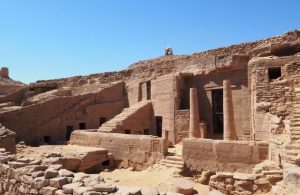
Harkhuf was an ancient Egyptian explorer during the 6th dynasty, and it seems that he liked his rulers’ idea of leaving a curse inside his tomb. Within his tomb, he left an inscription on the wall that largely talks about his experience in the afterlife.
However, he also goes on to leave a warning for anyone who dares step foot in his tomb to disturb his peace. The inscription reads, “As for any man who shall enter into this tomb, I will seize him like a wild fowl. He shall be judged by the great god.”
Although this might not seem like a particularly threatening message, by ancient Egyptian standards, this was a curse you didn’t want to mess with. In the Age of the Pyramids, being cursed by the Great God was the worst curse that anyone could wish upon you.[7]
3 The Tomb of Ankhmahor
The tomb of Ankhmahor is yet another tomb located in Saqqara. This tomb, like many others in the area, contains a curse that helps dissuade tomb raiders from entering the dead man’s final resting place.
This particular inscription reads, “As for that which anyone might do against this my tomb, the same will be done to his property. I am an excellent priest, knowledgeable in secret spells and all forms of magic, and as for anyone who enters my tomb impure or who does not purify themselves, I shall seize him like a goose and fill him with fear at seeing ghosts upon the earth.”
In other words, the priest buried within this tomb knows magic and isn’t afraid to use it! So if you find yourself exploring Saqqara at any time in the near future, you might want to avoid this particular burial site.[8]
2 The Tomb of Senenmut
Senenmut was a high priest and was the royal advisor to Queen Hatshepsut. In fact, there are even some who say the two were lovers.
Whether or not Senenmut and the Queen ever had anything going on, after Senenmut died, his tomb was constructed close to the Queen’s and her pharaoh’s. This was a huge privilege at the time, which is why some believe there may have been some funny business happening.
The tomb is quite well preserved, and when archaeologists uncovered it, they found it contained an eerie curse. The tomb contained an inscription that read, “His lifetime shall not exist on earth,” a curse meant for anyone who dared trespass in Senenmut’s resting place.
Thankfully, this warning doesn’t seem to have deterred modern-day archaeologists, who have made numerous key discoveries about ancient Egypt by exploring the tomb.[9]
1 The Tomb of Hezi
The tomb of Hezi is located in Saqqara, a popular burial site in ancient Egypt. This particular tomb holds the body of a nobleman who lived during the Old Kingdom in ancient Egypt.
As with many other tombs, the hieroglyphic inscriptions on the walls of this burial site start out talking about the life of Hezi. However, from there, things get a bit odd.
After the biographical part of the text, the hieroglyphics launch into a short yet effective curse, “As for anyone who will enter this tomb after he has eaten abominations or after he has copulated with women; I will be judged with him in the council of the Great God.” Interestingly enough, this curse almost seems to condemn not only the trespasser but also Hezi himself. Let’s just hope no one brought about those unfortunate consequences to either themselves or the dead man.[10]




